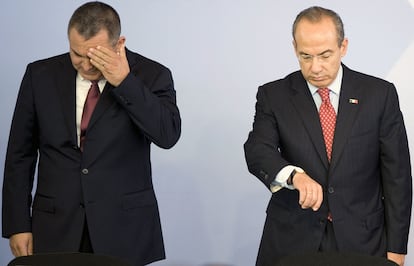The fall of Genaro Garcia Luna, Mexico’s drug czar
The trial of former president Felipe Calderón’s secretary of public security demolishes the myth of the super-policeman who took on the cartels and reveals him to be the partner of the criminals he promised to fight

Never before has the link between the Mexican authorities and drug-trafficking been so clearly exposed. Genaro García Luna, the face of Mexico’s drug war, was found guilty in the United States of all charges against him. The verdict of the Eastern District Court of New York has dismantled the image García Luna built of himself as Mexico’s strongman on drugs and unveiled the former secretary of security – who was one of the closest and most influential men in the Cabinet of president Felipe Calderon (2006-2012) and a trusted partner of the White House – to be a close collaborator of the Sinaloa Cartel, who accepted multimillion-dollar bribes.
Mexico is still reeling from the implications of a historic ruling: the fall of the highest-ranking Mexican official to ever set foot in a US courtroom for drug trafficking and organized crime. “Garcia Luna, who once stood at the pinnacle of law enforcement in Mexico, will now live the rest of his days having been revealed as a traitor to his country,” Washington stated after learning of the decision of the 12 members of the jury.
Confidant of former president Calderón, architect of the hunt against drug lords, ambitious and feared official – much of what was known about the early years of the war against drug trafficking in Mexico came from journalism, books, series and movies. This time, however, it was the protagonists who revealed everything themselves with no intermediaries: the drug traffickers exposed how they paid millions of dollars in bribes to authorities at all levels, how they disguised themselves as police officers to capture their rivals and how they had agreements on how to distribution of drug trafficking profits.
The trial was something of a narco testimonial, the sequel to the trial against Joaquin “El Chapo” Guzman in 2018: in the same court and before the same judge. The chain of complicity was embellished with the eccentricities of the jailed criminals, like when Colombian Harold Poveda “El Conejo” cried on the stand as he recalled his collection of exotic animals or when Tirso Martinez “El Futbolista” explained that he earned that nickname because he owned four professional soccer teams. But it was not just criminals who pointed their damning finger at Garcia Luna, he was also accused by former police officers who had been punished for refusing to collaborate with the cartels, other corrupt ex-officials and US agents who recounted in frustration how trust in their Mexican counterparts had eroded.

The defense presented photographs of the defendant with public figures of the caliber of former president Barack Obama or former presidential candidates such as Hillary Clinton and John McCain. But it was not enough. The prosecution was able to prove the accusations without delving into García Luna’s time at Cisen, Mexico’s chief civilian spy agency for more than a decade; or when he simulated the arrest of a gang of kidnappers so that it could be broadcast live on television; and even without presenting to the jury the real estate empire he built in Miami since 2013, under suspicion of misappropriation of public funds. The Mexican government wants that money back and filed a civil lawsuit in Florida in October 2021 for the embezzlement of more than $700 million.
The former official who is in the spotlight in Mexico had his first important position in 2001, when he became director of the Federal Investigation Agency (AFI), which was created during the government of Vicente Fox (2000-2006). He was in the immediate circle surrounding the Cabinet of that administration, but he was shy, had a stutter and barely spoke in meetings with the president. Behind the scenes, he received monthly bribes of more than a million dollars from the Sinaloa Cartel. García Luna was a loyal ally: he gave them uniforms, vehicles and official credentials to carry weapons for the exclusive use of the authorities. He leaked them sensitive information so they would not be caught. He would pick up the suitcases of money himself after sitting and talking for hours with the capos. That was what was said during the trial and what ceased to be a disputed truth after the verdict, at least in the eyes of the law.
At the end of 2006, when Calderón came to power, García Luna was appointed – to the surprise of everyone – secretary of public security. His task was to build the Federal Police, a corporation that in six years of his management multiplied its strength by five, to almost 40,000 troops. There was no other administration that collaborated more with the White House on security issues. Decorated and praised by the United States, the accused no longer went in person to pick up the bribes, but he was still in constant communication with the criminals. He went so far as to charge $3 million for 15-minute meetings, according to the testimonies of Óscar Nava Valencia “El Lobo” and Jesús “El Rey” Zambada, two of the most feared drug traffickers at the time.
Federal agents helped drug traffickers unload drug packages from airplanes, helped them hide and then pretended to look for them. Criminal bosses had access to the highest echelons of politics. Like García Luna, they had them on the payroll: judges, governors, journalists, authorities at all levels. The cartels grew like never before. “It would have been impossible without the help of the government,” said Sergio Villarreal “El Grande,” a former senior lieutenant in the cartel. “The ruling is being used to attack me,” said Calderón, who obtained a residence permit in Spain last October, after learning of the ruling on Tuesday.
The prosecution opted to build the case on testimonies and use little physical evidence. The issue still sparks debates on the other side of the border, 1,800 miles (3,000 kilometers) away from where García Luna’s fate was decided. The judge is expected to hand down his sentence at the end of June. The former official is facing a sentence of 20 years to life in prison.
Sign up for our weekly newsletter to get more English-language news coverage from EL PAÍS USA Edition
Tu suscripción se está usando en otro dispositivo
¿Quieres añadir otro usuario a tu suscripción?
Si continúas leyendo en este dispositivo, no se podrá leer en el otro.
FlechaTu suscripción se está usando en otro dispositivo y solo puedes acceder a EL PAÍS desde un dispositivo a la vez.
Si quieres compartir tu cuenta, cambia tu suscripción a la modalidad Premium, así podrás añadir otro usuario. Cada uno accederá con su propia cuenta de email, lo que os permitirá personalizar vuestra experiencia en EL PAÍS.
¿Tienes una suscripción de empresa? Accede aquí para contratar más cuentas.
En el caso de no saber quién está usando tu cuenta, te recomendamos cambiar tu contraseña aquí.
Si decides continuar compartiendo tu cuenta, este mensaje se mostrará en tu dispositivo y en el de la otra persona que está usando tu cuenta de forma indefinida, afectando a tu experiencia de lectura. Puedes consultar aquí los términos y condiciones de la suscripción digital.
More information
Archived In
Últimas noticias
Most viewed
- Sinaloa Cartel war is taking its toll on Los Chapitos
- Oona Chaplin: ‘I told James Cameron that I was living in a treehouse and starting a permaculture project with a friend’
- Reinhard Genzel, Nobel laureate in physics: ‘One-minute videos will never give you the truth’
- Why the price of coffee has skyrocketed: from Brazilian plantations to specialty coffee houses
- Silver prices are going crazy: This is what’s fueling the rally










































